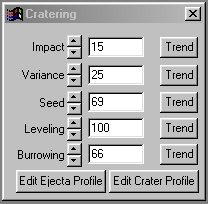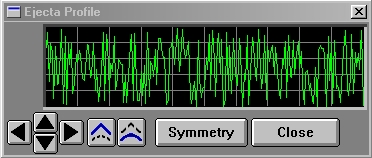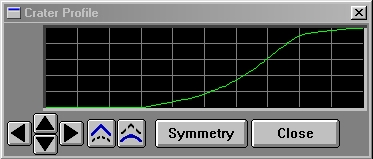| This is a child page. You can use Parent in the quick nav bar at the top or the bottom of the page to navigate directly back to the parent of this page. Some child pages are more than one level deep, and in that case will require more than one Parent click to reach the outermost document level. |
§ 16.85 - Crater
| Quick Reference to Scripting Command |
| a=CRATER(impact, variance, seed, level, burrowing) |
| Items in CAPS are 0/1 or ranges with more options than just 0/1. Ranges other than 0/1 are indicated by brackets, such as [0-2]. |
§ 16.85.1 - Crater Controls
§ 16.85.1.1 - Trends
Operator dialog controls that have a Trend button next to them offer animation functionality. Trend allows you to set that variable over a set of frames. Each frame of the animation can be thought of as a slice of time. The trends allow you to alter some, all, or none of the variables for a particular time slice. Variables that have multiple states can be set to any of a number of values in the trend. Variables that are either on or off can only have an on or off value in the trend. You will notice that the trend graphs have equidistantly spaced vertical lines. Each of these lines represents a frame in the animation. The number of frames can be altered using Sequence controls... in the TimeLine pull down menu. Animation lengths of 100 - 999 frames will be represented with a vertical bar being 10 frames, and animation length greater than 1000 frames will have a vertical bar for every 100 frames. Click here to view more information on Trends.
§ 16.85.1.2 - Impact
This controls the impact of the object.
§ 16.85.1.3 - Variance
This controls how random the effects of the impact are.
§ 16.85.1.4 - Seed
This provides a means for repeatable, but random, crater generation. The range is 0 to 32767.
§ 16.85.1.5 - Leveling
This controls how much the impact melts, then reforms, thereby leveling the ground in the impact region.
§ 16.85.1.6 - Burrowing
This controls how far the object penetrates.
All profiles can be controlled via scripting.
There are two general scripted mechanisms that allow reading and writing to individual profile entries.
These use a name that we have assigned to the profile, an index of zero to 200 to address the 201 entries in each profile, and a value, either read or written:
a=GETPROF("name", index[0-200])
(returns value in a)
a=SETPROF("name", index[0-200], value)
(returns previous value in a)
You will find the various profile names detailed here.
Examples of setting entire profiles with small script routines are detailed here.
§ 16.85.1.7 - Ejecta Profile
This profile describes the radial profile of debris thrown from the crater.
When this operator is dragged into the timeline, profiles will automatically trend to the next profile, if another exists in the timeline.
§ 16.85.1.8 - Crater Profile (center to edge)
This profile describes the profile of the crater as it would appear taken as a radial cut.
When this operator is dragged into the timeline, profiles will automatically trend to the next profile, if another exists in the timeline.
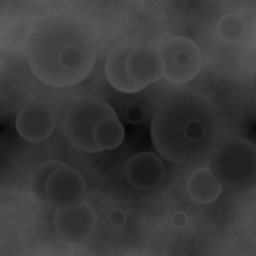 Cratered Heightfield |
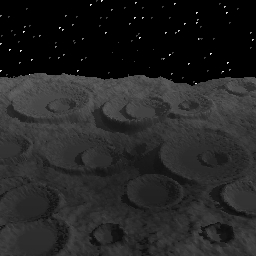 3d Result of Original |
, Previous Page . Next Page t TOC i Index o Operators g Glossary
Copyright © 1992-2007 Black Belt Systems ALL RIGHTS RESERVED Under the Pan-American Conventions
WinImages F/x Manual Version 7, Revision 6, Level A
